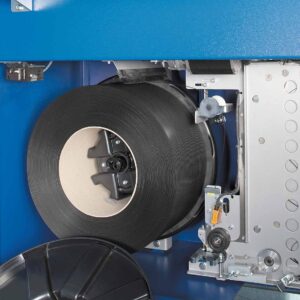PP (Polypropylene) strapping band and PET (Polyester ) strapping band differ significantly in terms of their material characteristics, strength, and intended uses. Here’s a fresh breakdown:
- Material Properties:
PP Strapping band: Made from polypropylene, a lighter, flexible plastic with moderate strength. It’s primarily used for packaging tasks that don’t demand heavy load-bearing capacity.
PET Strapping band: Made from Polyester, a tougher, more durable plastic with a higher resistance to breaking under strain. It’s suited for more demanding applications that require stronger securing. - Strength and Load Capacity:
PP Strapping band: Suitable for lighter loads, such as cartons or smaller packages. Its tensile strength is lower, making it ideal for situations where extreme force is not applied to the package.
PET Strapping band: Designed for heavier loads, such as pallets of bricks, steel, or bulky industrial items. PET has high tensile strength, allowing it to hold firm even under substantial pressure. - Elasticity and Tension Retention:
PP Strapping band: Has more flexibility, which can lead to stretching under stress. While this can be beneficial in some cases, over time, PP tends to lose tension, making it unsuitable for packages that may expand or shrink.
PET Strapping band: Has much less stretch and maintains tension over extended periods. This characteristic makes it highly reliable for securing loads that need stable, long-term binding. - Environmental Tolerance:
PP Strapping band: Susceptible to UV degradation and can become brittle over time when exposed to direct sunlight or varying weather conditions. It’s better suited for indoor storage or short-term use.
PET Strapping band: More resistant to environmental factors such as UV radiation, heat, and cold. It retains its properties well even in outdoor or extreme conditions, making it a better choice for outdoor storage or long-distance shipping. - Cost Considerations:
PP Strapping band: Generally more affordable due to its lighter material and suitability for simpler tasks. It’s a cost-effective choice for lower-strength applications.
PET Strapping band: Tends to be pricier because of its superior strength and durability. However, the higher cost is often offset by the reduced need for frequent replacement or re-strapping for heavy-duty use. - Application Types:
PP Strapping band: Ideal for securing boxes, light pallets, and general-purpose packaging in industries like retail, food, or consumer goods where heavy loads aren’t a concern.
PET Strapping band: Used for industrial applications, such as securing heavy pallets, building materials, or metal products, where strength and durability are essential.
Conclusion:
PP strapping band is a budget-friendly solution for lightweight packaging needs, offering flexibility and ease of use for simpler tasks.
PET strapping band is a high-performance option that excels in strength, durability, and tension retention, making it indispensable for heavy-duty packaging and long-term storage.
This rewritten explanation highlights the essential differences while avoiding redundancy from existing sources.

